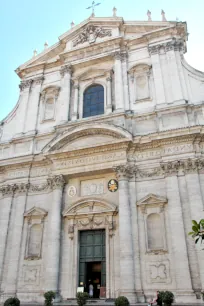The church of Sant’Ignazio is dedicated to St. Ignatius of Loyola, founder of the Jesuit order, who played a crucial role in the counter-reformation. The church is best known for its magnificent ceiling painting that glorifies the saint.



Sant’Ignazio is the second most important Jesuit church in Rome, after the nearby Gesù church, where Ignatius is buried.
Construction
Construction of the Sant’Ignazio church started in 1626 with funds provided by cardinal Ludovico Ludovisi, a nephew of Pope Gregory XV. The church was built for the Collegio Romano, a Jesuit school, and replaced an older, smaller church. It was dedicated to St. Ignatius, who had only a few years before, in 1622, been declared a saint.
The church was built by one of the order’s members, Orazio Grassi, who created his design with help from Carlo Maderno. The Baroque facade was designed by Alessandro Algardi, who built it in 1649. The church was only fully completed in 1685. The planned dome was never realized, allegedly because it would block the sun from entering the library of the Collegio Romano.
Interior
The interior is spacious and, in true Jesuit tradition, no surface has been left unadorned. Everywhere you look it is richly decorated with marble, stucco, gilded ornaments and magnificent frescoes. Some noteworthy sights include the funerary monuments of Pope Gregory XV and his nephew Ludovico Ludovisi, both created by Pierre Legros the Younger. The chapels in the transept hold the remains of two canonized members of the Jesuit order: Jan Berchmans, a priest from Flanders, is entombed in the left chapel, while an urn in the altar of the right transept holds the remains of the Lombardian saint Aloysius Gonzaga.
Frescoes

But the main highlight of the church is without a doubt the magnificent frescoes, created in 1685 by another Jesuit, Andrea Pozzo. The ceiling painting, which covers the whole length of the nave, depicts the entry of Ignatius into paradise. The ceiling of the never-built dome is covered with a dark trompe-l’œil, which gives the impression of an actual dome. Four large allegorical figures represent the four continents across which the Jesuits wanted to spread the Christian religion.
The whole composition is an ingenious realization of perspective. Pozzo masterfully integrated his fresco into the overall architecture. If you stand on the marble disc at the center of the church, you’ll see the full effect of the perspective rendering: figures that are in reality painted horizontally seem to rise up towards heaven. From here, the dome also seems to have a real vaulting, while it is in fact completely flat.

